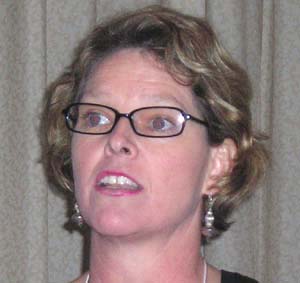 |
| Healthy Reefs, Dying Reefs, and Corals in Bocas del Toro, Panama:(A) Example of a healthy reef with abundant living coral. (B) Example of a reef in which most coral has died and been replaced by macroalgae. (C) Bleached and healthy coral colonies; both are alive but the bleached colony has lost its symbiotic algae. (D) Coral suffering from disease and with encroaching macroalgae. |
Nancy Knowlton & Jeremy B. C. Jackson
Imagine trying to understand the ecology of tropical rainforests by studying environmental changes and interactions among the surviving plants and animals on a vast cattle ranch in the center of a deforested Amazon, without any basic data on how the forest worked before it was cleared and burned. The soil would be baked dry or eroded away and the amount of rainfall would be greatly decreased. Most of the fantastic biodiversity would be gone. The trees would be replaced by grasses or soybeans, the major grazers would be leaf-cutter ants and cattle, and the major predators would be insects, rodents, and hawks. Ecologists could do experiments on the importance of cattle for the maintenance of plant species diversity, but the results would be meaningless for understanding the rainforest that used to be or how to restore it in the future.
Fortunately, ecologists began to carefully describe tropical forests more than a century ago, and vast areas of largely intact forests have persisted until today, so there are meaningful baselines for comparison. Networks of 50-hectare plots are monitored around the world [1], and decades of experiments have helped to elucidate ecological mechanisms in these relatively pristine forests [2]. But the situation is very different for the oceans, because degradation of entire ecosystems has been more pervasive than on land [3] and underwater observations began much more recently. Monitoring of benthic ecosystems is commonly limited to small intertidal quadrats, and there is nothing like the high-resolution global monitoring network for tropical forests for any ocean ecosystem.
This lack of a baseline for pristine marine ecosystems is particularly acute for coral reefs, the so-called rainforests of the sea, which are the most diverse marine ecosystems and among the most threatened [4–8]. Most of the world’s tropical coastal oceans are so heavily degraded locally that “pristine” reefs are essentially gone, even if one ignores changes associated with already rising temperatures and acidity [3]. Most modern (post-SCUBA) ecological studies have focused on reef ecosystems that are moderately to severely degraded, and we have a much better understanding of transitions between human-dominated and collapsed reefs than between human-dominated and quasi-pristine reefs. Even the classic studies of Caribbean reefs that began in the 1950s were based on reefs that had very high coral cover but were severely overfished, and the first systematic surveys of subtidal Australian reefs in the late 1960s began after a severe outbreak of the crown-of-thorns starfish Acanthaster planci had devastated coral populations along much of the Great Barrier Reef. We are thus left without a clear understanding of how reefs functioned in the absence of major human impacts.

 After the flooding in late January in the Fitzroy catchment, and the downpour in Mackay causing rising levels in the Pioneer river earlier this month, the turbulent Queensland weather has caused more phenomenal localised rainfall in Rockhampton this morning, with
After the flooding in late January in the Fitzroy catchment, and the downpour in Mackay causing rising levels in the Pioneer river earlier this month, the turbulent Queensland weather has caused more phenomenal localised rainfall in Rockhampton this morning, with  The “
The “




